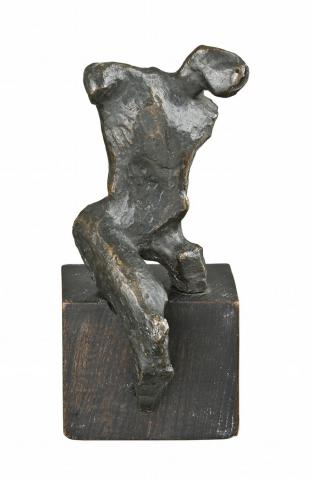MAQUETTE FOR WARRIOR WITHOUT SHIELD, 1952-53
Henry Moore
bronze, dark brown patina
18.5 cm height
edition: 9
Waddington Galleries, London, 1995
Private collection, Frankfurt
Thence by descent
Private collection, Melbourne
Bowness, A., (Ed.) Henry Moore, Complete Sculpture 1949–54, London, 1986, vol. 2, p. 52, no. 358, (illus. another example)
Henry Moore's Titanesque Maquette for Warrior Without Shield, 1952, has its antecedents in Michelangelo and Classical Greek sculpture and mythology. Though small in size, it is monumental in concept and feeling, the dynamics of the male human figure employed to express ideas of epic proportion. The warrior, precariously balanced on its base, recalls Michelangelo's massive marble figures of Night and Day, Evening and Dawn on the Medici tombs in the Sagrestia Nuova of San Lorenzo, Florence. Moreover, the tensions and inner struggles expressed through the musculature of Moore's bronzed figure have an affinity with Michelangelo's marble Slaves, as seen in the Louvre, Paris, and Florence's Accademia. Drawing inspiration from such marvels of the High Renaissance, Moore likewise felt the impact of the Acropolis sculptures, found in the pedimental carvings and friezes of the Parthenon in the British Museum. Fascinated by these heroes of ancient mythology, the Hellenic influence was heightened by his visit to Greece in 1951. None imitate; but as in all great art, they are informed by the past as inspiration grows out of and matches inspiration.
Moore wrote that the idea for The Warrior came to him in the early 1950s. 'It was evolved from a pebble I found on the seashore in the summer of 1952, and which reminded me of the stump of a leg, amputated at the hip. Just as Leonardo says somewhere in his notebooks that a painter can find a battle scene in the lichen marks on a wall, so this gave me the start of The Warrior idea.'1 Moore explored the concept through a wounded warrior image, then one with a shield, the figure, he wrote, 'though wounded, is still defiant' The head has a blunted and bulllike power but also a sort of dumb animal acceptance and forbearance of pain.' Of our bronze, he commented, 'The version without a shield is even more agonizing that that with the shield; the long right arm clutches senselessly in the void, whereas in the other version the shield supports the figure and the whole sculpture and gives it balance. The treatment of the surface is rough and cracked, as though to prevent a tautness and nobility of physique from diminishing the tragedy of this Patroclus figure.' Moore's experiences in the First and Second World Wars had a deep influence on these sculptures. In Maquette for Warrior Without Shield, the figure has been reduced to its basic elements with a characteristic blend of figurative and abstract elements. Moore found the meaning and power of life in the organic forms of nature, here present in the powerful bronze figure of this maquette.
1. Moore, H., letter of 15 January 1955, quoted in James, P. (ed.), Henry Moore on Sculpture: A Collection of the Sculptor's Writings and Spoken Words, Macdonald, London, 1966, p. 250
DAVID THOMAS
